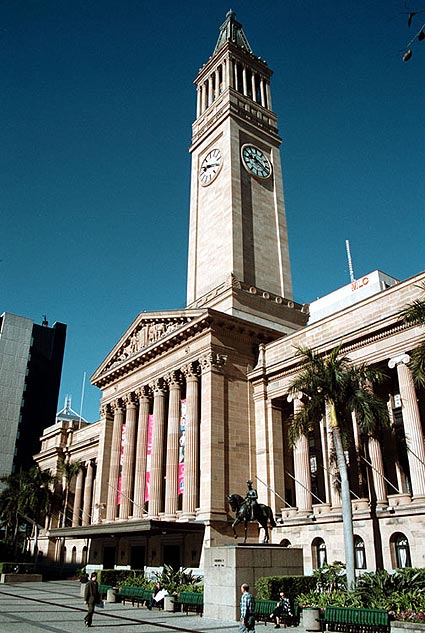
Brisbane City Hall
[Photograph by Trevor Bunning (October 2007)]
Historical and Technical Documentation by Geoffrey Cox
© OHTA 1989, 2007, 2015 (last updated February 2020)

Brisbane City Hall
[Photograph by Trevor Bunning (October 2007)]
Historical and Technical Documentation by Geoffrey Cox
© OHTA 1989, 2007, 2015 (last updated February 2020)
This large sandstone-faced steel and concrete building was designed by architects T.R. Hall & G.G. Prentice and built in 1920-30. It was opened on 8 April 1930. The imposing main facade fronting the square includes a tympanum sculpture by local artist Daphne Mayo, depicting the settlement of Queensland. The organ is housed in the central circular copper-domed Concert Hall. The main casework of the organ was designed by Hall and Prentice, and constructed of Queensland maple.1
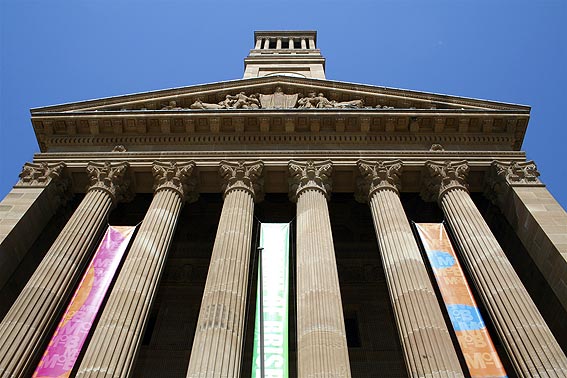
Tympanum sculpture by Daphne Mayo
[Photograph by Trevor Bunning (October 2007)]
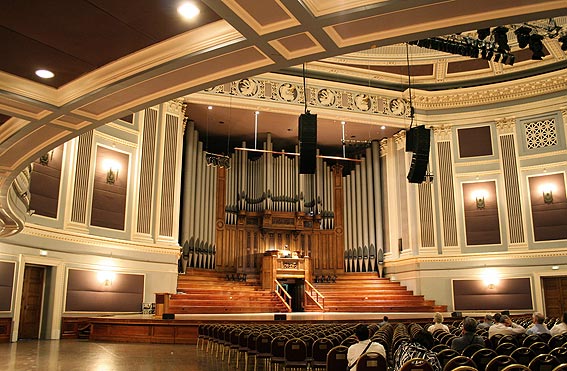
The organ within the circular copper-domed Concert Hall
[Photograph by Trevor Bunning (October 2007)]
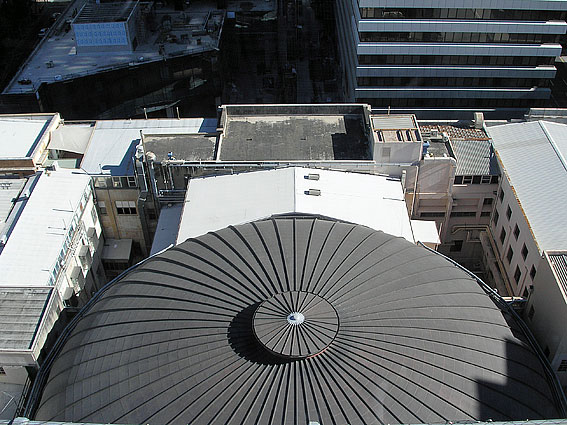
The dome over the Concert Hall, viewed from the tower
[Photograph by Simon Colvin (May 2008)]
The organ was built in 1891-92 by Henry Willis and Sons, London, for the Brisbane Exhibition Building (subsequently the Queensland Art Gallery and Museum) in Bowen Park.
The search for a suitable public organ for Brisbane was well under way as early as March 1887, when George Fincham of Melbourne supplied two schemes for a 'Concert Organ for Brisbane, Queensland,' one of four manuals (51 speaking stops) and the other of three manuals (41 speaking stops), both with tubular-pneumatic action, and costing £3000 and £2400 respectively.2 The intended location is not stated, but it was probably either for a proposed new Town Hall, or for Brisbane's original Exhibition Building at Bowen Park. When the old Exhibition Building was destroyed by fire in June 1888, plans for a new building began immediately, and the new Exhibition building, now known as the Old Museum Building, was opened in August 1891. The Willis organ was ordered in June 1891.3
The firm Henry Willis & Sons, London, was headed at this time by its founder, 'Father' Henry Willis (1821-1901), and the Brisbane instrument was of similar size to, and almost contemporary with, the instrument that Willis built for Blenheim Palace, Woodstock, Oxfordshire, UK (1891). The Blenheim instrument still survives today in original condition. Writing some years later in The Rotunda, Willis's grandson, Henry Willis III, described the Brisbane Exhibition organ as follows:
On 7th June, 1891, my grandfather was commissioned to build an organ for the Concert Room of the Brisbane Exhibition Buildings....
The completed organ was on view in the old "Rotunda" in Camden Town, and many eminent musicians, including Sir John Stainer, Dr. Turpin, Mr. H. L. Balfour, Dr. Davan Wetton, played upon it and expressed the greatest delight with the instrument. Dr. Wetton, who was the assistant organist at Westminster Abbey, stated "It is an instrument full of quality, the repetition is wonderful, and the general mechanism perfection, the old gentleman being very pleased with the work he has turned out". (the "old gentleman" was, of course, Father Willis.)
There is no doubt that my grandfather was exceedingly proud of the organ, and his only regret, voiced in letters to his friends, was that it was going to "the other side of the world," and that he would not be able to hear and play it in position. The specification was a typical "Willis" one of the period, the only unusual feature being the metal Contra Violone 32-ft on the Pedal Organ, the pipes being used in the front. . . .
It is interesting to note that in 1892 this organ was considered to be the "last word" as regards perfection of mechanism.
The action was tubular-pneumatic upon the Vincent Willis Patent 15182, A.D. 1889. The console was detached, an unusual feature in those days. Only four pistons were provided to Great and Swell organs respectively and they were not adjustable, not even at pneumatic switchboards. A device then considered very advanced was a coupler stop "Great pistons to combination pedals"!
The instrument was sent out via the Torres Strait route and arrived in Brisbane in September, 1892. Through the courtesy of the Collector of Customs it was admitted free of duty. The erection of the organ was carried out by one of the firm's representatives with local assistance.4
Early in September 1892, the organ was reported to be on its way down the Queensland coast in R.M.S. Avoca.5 It arrived in Brisbane on 13 September, and was soon being erected in the Exhibition Building under the supervision of Mr Simpson, representing the Willis firm.6
A complete description of the organ appeared in The Brisbane Courier on 19 December 1892, including the specification, and this is probably now the most reliable available source for the details of the instrument. The specification is given here from that source, with additional information [in square brackets] that appeared much later in The Rotunda, vol. 2, no. 1 (September 1927), pp. 1-2:
The instrument consists of four complete manuals from CC to A, fifty-eight notes; and two and a half octaves of concave and radiating pedals, [CCC to F] thirty notes:
1.
2.
3.
4.
5.
6.
7.
8.
9.
10.
11.
12.
Double Open Diapason
Open Diapason
Open Diapason
Claribel Flute
Flute-harmonique
Principal
Twelfth
Fifteenth
Sesquialtera
Double Trumpet (prepared for)
Trumpet
Clarion
16ft
8ft
8ft
8ft
4ft
4ft
3ft
2ft
3 ranks
[16ft]
8ft
4ft
metal
metal
metal
wood
metal
metal
metal
metal
metal
metal
metal
[closed bass]
[Trombone 16ft elsewhere – see fn. 7]
1.
2.
3.
4.
5.
6.
7.
8.
9.
10.
11.
12.
13.
14.
Lieblich Bourdon
Lieblich Gedact
Lieblich Flöte
Geigen Principal
Gemshorn
Flageolet
Salcional
Vox Angelica
Mixture
Double Trumpet
Cornopean
Hautboy
Vox Humana
Clarion
16ft
8ft
4ft
8ft
4ft
2ft
8ft
8ft
3 ranks
16ft
8ft
8ft
8ft
4ft
[std] wood & metal
wood & metal
wood & metal
metal
metal
metal
metal
metal
metal
metal
metal
metal
metal
metal
[undulating to T.C.: bass derived from No. 7]
[& Tremulant]
1.
2.
3.
4.
5.
6.
7.
Dulciana
Lieblich Gedact
Claribel Flute
Viola da Gamba
Flûte d'Amour
Piccolo-harmonique
Corno di Bassetto
8ft
8ft
8ft
8ft
4ft
2ft
8ft
metal
[std] wood & metal
wood
metal
metal
metal
metal
[closed bass]
1.
2.
3.
4.
5.
Flute-harmonique
Concert Flute
Clarionet
Orchestral Oboe
Tuba
8ft
4ft
8ft
8ft
8ft
metal
metal
metal
metal
metal
1.
2.
3.
4.
5.
6.
7.
8.
Contra Violone
Violone
Open Diapason
Octave
Bourdon
Flute Bass
Ophicleide
Posaune
32ft
16ft
16ft
8ft
16ft
8ft
16ft
8ft
metal
metal
wood
wood
[std] wood
[std] wood
metal
metal
[derived from No. 1]
[derived from No. 3]
[derived from No. 5]
1.
2.
3.
4.
5.
6.
7.
8.
9.
10.
11.
Solo to Great
Swell to Great Super Octave
Swell to Great Unison
Swell to Great Sub Octave
Choir to Great
Swell to Choir
Solo to Pedals
Swell to Pedals
Great to Pedals
Choir to Pedals
[Great] pistons to composition pedals*
[pneumatic]
[pneumatic]
[pneumatic]
[pneumatic]
[pneumatic]
[pneumatic]
[mechanical]
[mechanical]
[mechanical]
[mechanical]
[* This stop enables the player to change Pedal and Great Organs ad libitum by the composition pedals - the Pedal can therefore be, by these means, severed from the Great Organ.]
[ACCESSORIES]
4 pneumatic combination pistons to Great Organ
4 pneumatic combination pistons to Swell Organ
Double-acting pneumatic pistons for the Great to Pedal coupler and Swell to Great coupler
[placed in the Great Organ slip]
4 composition pedals to Great and Pedal Organs
4 composition pedals to Swell Organ
[Sir John Stainer] crescendo pedals to Swell and Solo Organs
Tremulant to Swell.
[WIND PRESSURES]
[Great Organ: Flue work 3-1/2 ins, Reeds 7 ins.]
[Swell Organ: Flue work, Vox Humana and Hautboy 3-1/2 ins., Chorus Reeds 7 ins.]
[Choir Organ: Throughout 3-1/2 ins.]
[Solo Organ: Light pressure 3-1/2 ins., Tuba 15 ins.]
[Pedal Organ: Flue work 3-1/2 ins., Reeds 10 ins.][PITCH: Old Concert Pitch, C. 540.]7
Photographs of the organ at the Exhibition Building show the central façade pipes largely as they came to be configured at the City Hall. The present large flats on either side, which contain the longest pipes of the Pedal Contra Violone 32ft, originally extended backwards down the two sides of the organ. The façade pipes were diapered, and the Choir Organ was unenclosed, speaking through an open grille beneath the impost.
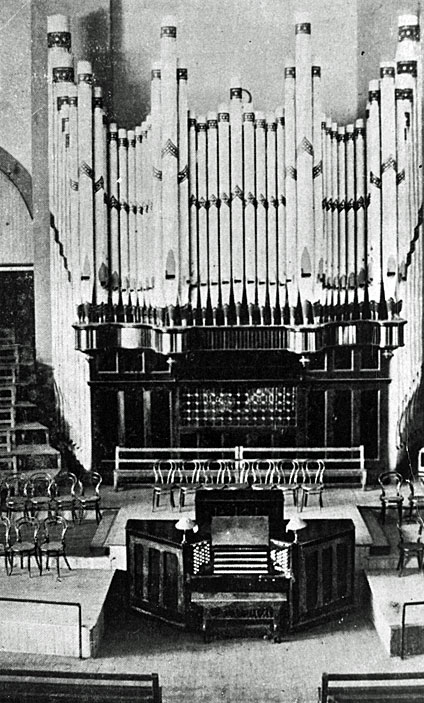
The Exhibition Organ, before 1906
[Photograph from F. J. Brewer & R. Dunn,
Sixty-Six Years of Municipal Government
(Brisbane: Standard Press, 1925), p. 126]8
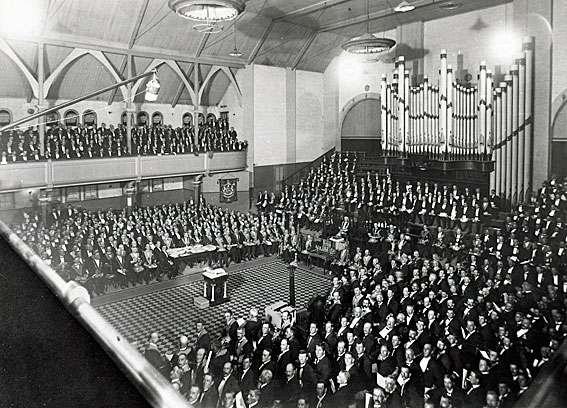
Concert Hall of the Brisbane Exhibition Building, Bowen Hills (c.1900)
[Photograph: Brisbane City Council (BCC-B120-2717)]
Controversy arose over the question of who should present the inaugural recital. This was centered around the choice between four local recitalists and a proposal to invite the Sydney City Organist, Mr Auguste Wiegand.9 In the end, the opening recital on 20 December 1892 was divided between four Brisbane organists: Mr W.G. Willmore, Mrs Willmore (Madame Mallalieu), Mr S.G. Benson and Mr Seymour Dicker.10 A series of weekly recitals soon followed, many involving associate artists. The local organists continued to provide recitals for many years to come, and Mrs Willmore's programme on Sunday 26 August 1894 was described as 'a string of gems.'11 Wiegand was engaged to give a series of three recitals at the end of August 1894, but the second and third had to be postponed because of winding problems in the organ.12
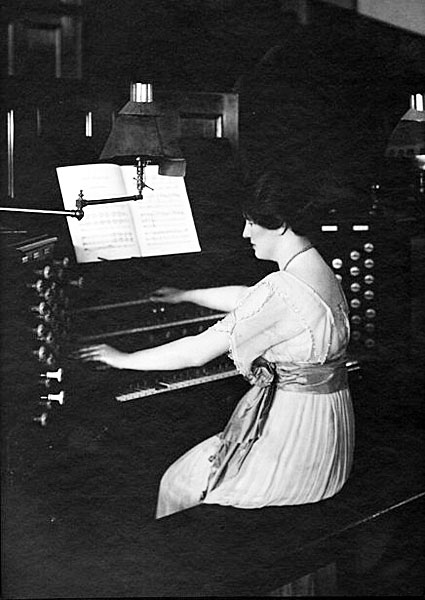
Mrs Willmore (Madame Mallalieu)
at the console of the Exhibition organ (probably c.1892-95)
[Photograph supplied by Simon Pierce]
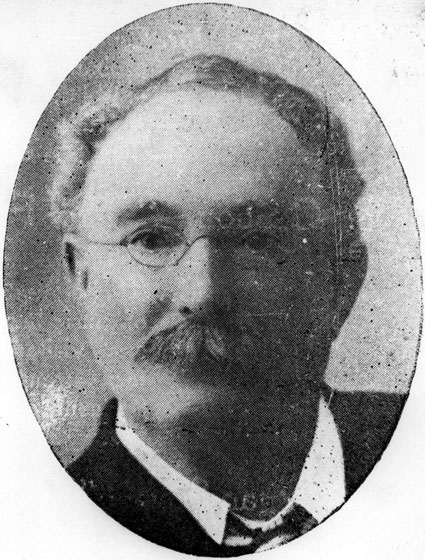
Samuel George Benson
[Photograph: John Oxley Library, State Library of Queensland]
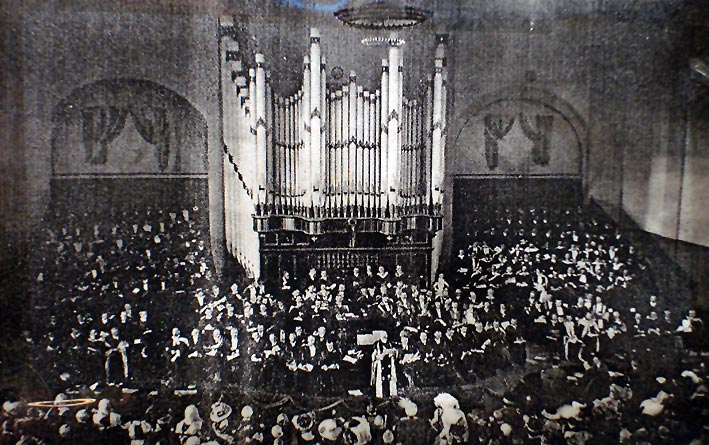
The Willis Organ at the Exhibition Building,
apparently during a concert or graduation ceremony
[Photograph found at the Old Museum by Rodney Ford (October 2007)]
As the decade progressed, disillusionment set in within the Queensland National Association, the owners of the organ,13 and there were proposals around 1898 to sell it to the Anglican Diocese of Brisbane for the proposed St John's Cathedral.14 In the end, the organ was purchased in January 1900 by the Brisbane City Council,15 and it remained in the Exhibition Building until it was removed in 1927 for rebuilding, enlarging and installation in the new City Hall.
Parts of the 1892 console were re-cycled by Whitehouse Bros in other organs they were building at the time: one of the keyboards, with its distinctive key cheeks and rounded accidentals, survives on the 1931 Whitehouse organ at Zion Lutheran Church, Minden, while the pedalboard and possibly another two keyboards (since replaced) went in 1933 to Scots Presbyterian Church, Clayfield.
Consultation between Henry Willis III and the City Organist, Mr George Sampson, F.R.C.O. resulted in a scheme to enlarge and modernise the organ. The Brisbane City Council formally approved the reconstruction of the instrument in April 1925, and the work was carried out by Whitehouse Bros of Brisbane in conjunction with Henry Willis & Sons of London. The local firm was responsible for all of the renovation work in Brisbane, as well as the construction of the 13 large new wooden pipes for the Pedal Double Open Bass 32ft.16 These pipes were made of Californian redwood, specially imported for the purpose, so that each of the four sides of the pipes could be made in one piece.17
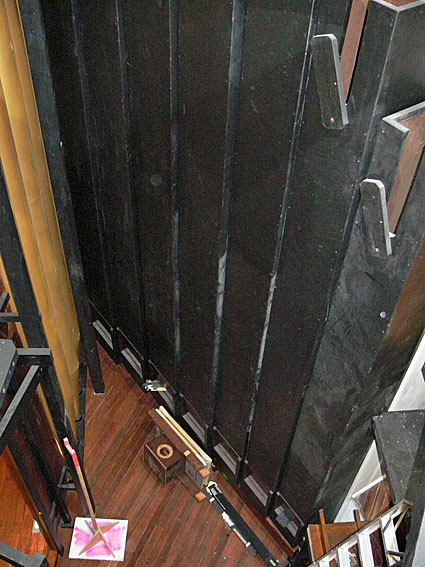
Pipes of the bottom octave of the Pedal Double Open Bass 32ft,
manufactured by Whitehouse Bros in 1928
[Photograph by John Maidment (March 2013)]
The official re-opening of the organ took place at a recital given on 8 April 1930, the day on which the City Hall itself was opened,18 although the organ had already been completed by 6 July 1929, when it was demonstrated to the aldermen. On this occasion, the Mayor, Alderman W.A. Jolly, addressed the invited audience, and Mr Sampson replied, concluding as follows:
I cannot say in words how grateful I am to the present and former City Council for giving me a free hand from the beginning, and I like to think that their confidence in me has not been misplaced. You have in some respects the finest organ in the world. I trust you will cherish it and keep it from the hands of incompetent performers. "Father" Willis, who built the original organ, was as supreme an artist in organ construction as the Amatis of Cremona were in violin making, and the present firm from my experience are carrying on his work in a superb manner. I see my old friend, Mr. J. Whitehouse. Mr. Whitehouse is my best testimonial. For thirty years he has attended almost without a break, my recitals. . . . I should like here publicly to congratulate him and his staff upon the work they have done in this matter. I do not think they have received half the credit which is their due. The whole of the work of rebuilding has been done by them in their Brisbane factory. To them was entrusted the important work of making the huge wooden pipes of 32 feet on the pedal organ. The tuning, regulating and voicing (in other words the musical part of the contract) is in their hands, and it could not have been in better ones, so confident am I of their ability.19
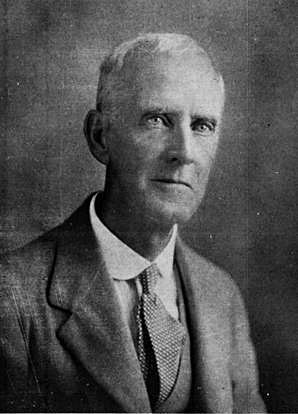
Mr George Sampson in 1920
[Photograph: John Oxley Library, State Library of Queensland]
Whitehouse Bros worked in co-operation with Willis,20 but the vast majority of the work of restoring and installing the organ was entrusted to the local firm. Mr Darrel McMullen, an employee of Whitehouse Bros between 1927 and 1941, recalls that only one Willis employee, Mr Thomas Colmer, visited Brisbane. Colmer reportedly stayed in Brisbane for around twelve months, and did not wait for the opening.21 He was farewelled at a special function in Brisbane in June 1929.22 The new Orchestral division, and the new console and underactions were supplied complete from the Willis firm in England.23
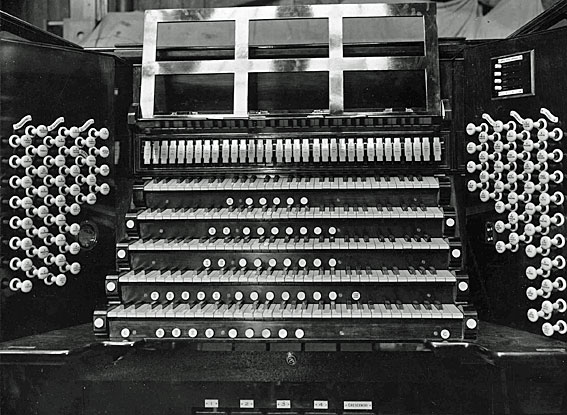
The Willis console of 1927, photographed at the builder's factory
[Photograph supplied by John Maidment]
A full description by Henry Willis III of the enlarged and rebuilt organ appeared in the Willis journal The Rotunda, vol. 2, no. 1 (September 1927), including the following details of the wind pressures and pitch:
WIND PRESSURE
Great Organ: Light Pressure 3-1/2 ins; Heavy Pressure 7 ins
Swell Organ: Light Pressure 3-1/2 ins; Heavy Pressure 7 ins
Choir Organ: Throughout 5 ins
Solo Organ: Light Pressure 7 ins; Diapason Stentor 15 ins; Tuba 20 ins.
Orchestral Organ: Light Pressure 7 ins; French Horn and Orchestral Trumpet 20 ins.
Pedal Organ: Light Pressure 3-1/2 ins; Open Diapason, Principal, Fifteenth and Mixture 6 ins; Contra Bass and 'Cello 10 ins; Reeds 15 ins.
PITCH: French Diapason Normal, i.e. C. 517 at a temperature of 59 deg. Fahrenheit.24
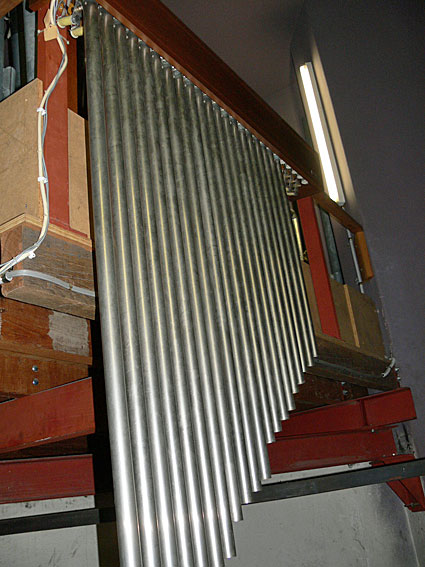
Cathedral Chimes, added to the Solo Organ in 1927-29
[Photograph by John Maidment (December 2009)]
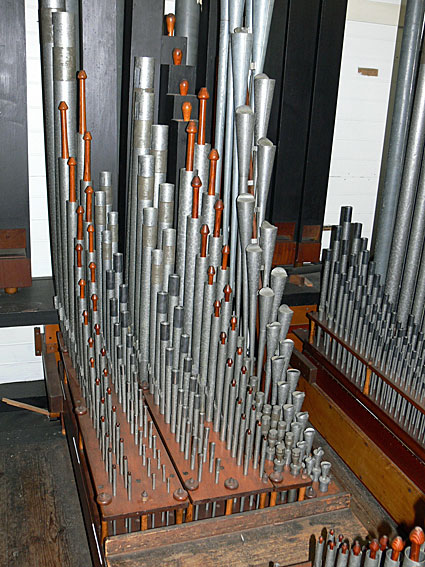
Pipework in the Swell Organ
[Photograph by John Maidment (December 2009)]
It will be observed that the pitch of the organ was lowered from Old Concert Pitch (C. 540) to French Diapason Normal (C. 517) at the time of the 1927-29 rebuild, and internal evidence shows that this was achieved by the addition of a new bottom pipe to each rank, and also by the addition of slides.
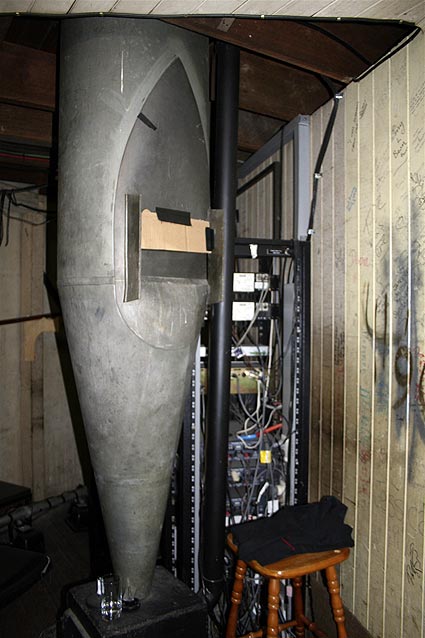
Bottom note added to the Pedal Contra Violone 32ft
[Photograph by Trevor Bunning (October 2007)]
Problems concerning the pitch of the organ were observed as early as November 1937, when it was noted that it was considerably 'flat' in relation to the Australian Broadcasting Commission's orchestral instruments:
MYSTERY OF CITY ORGAN PITCH SOLVED
Will Soon Be Ready To Play With Orchestra
THE mystery of the difference in pitch between the City. Hall organ and the Australian Broad' casting Commission's orchestral instruments has been solved by Mr. George Sampson, city organist, and the contractors for the organ, Messrs. B. B. Whitehouse and Coy. Ltd., who built and installed it in conjunction with Messrs. Willis, of London, believe that it will take only a few days to sharpen the pipes. . . .
Mr J. H. Whitehouse, managing director of B. B. Whitehouse and Co., said last night that now that the cause of the difference was known it would not be a difficult task to 'sharpen' the organ.
It would entail shortening, or coning out, the sound pipes in most cases, and opening or closing the slots of the bigger pipes seen in the front of the organ. It would take a few days of fine tuning to complete the task.
Mr. W. Nelson Burton, conductor of the Australian Broadcasting Commission's Orchestra, said yesterday that for a number of years various pitches had been in existence in Australia, resulting in concerts being marred owing to instruments of a different pitch being included in the same orchestra.
The Australian Broadcasting Commission had adopted the new philharmonic standard pitch of C. 522. . .25
Less than a year later, in August 1938, the pitch of the organ was raised (apparently in considerable haste) to C. 522 [= A. 440], in order to facilitate its use with the orchestra under the conductorship of Malcolm Sargent. The Australian Broadcasting Commission shared the cost of altering the pitch of the organ at this time.26
The pitch of the City Hall organ is to be raised from 517 to 522 by a simple inexpensive method. It is learned on the authority of Whitehouse Bros. whose firm is undertaking the necessary alterations, that the pitch is being altered because Dr. Malcolm Sargent declined to use any other organ but the pipe organ for his performance of Elijah, which is to be given in the City Hall late this month. Dr. Sargent insisted on using the pipe organ. It was therefore necessary to have the pitch of the City Hall organ raised to conform with the orchestral instruments.27
In 1927-29 and 1938, therefore, the pitch of the organ was altered in two different directions. These successive changes had a significant effect on the scaling and tone of the instrument, most critically affecting the reed stops.28
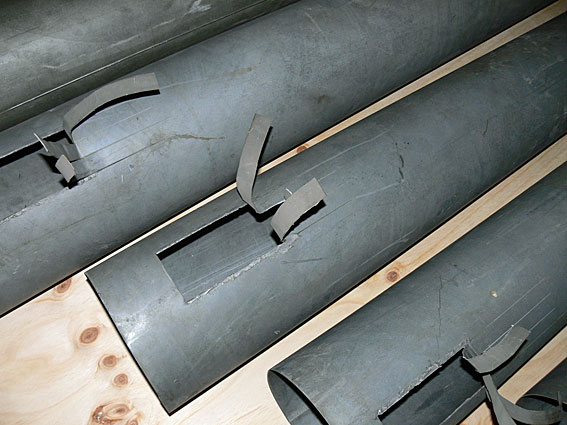
Pipes of the Ophicleide 32ft stop, showing slots torn down to raise the pitch
[Photograph by John Maidment (January 2010)]
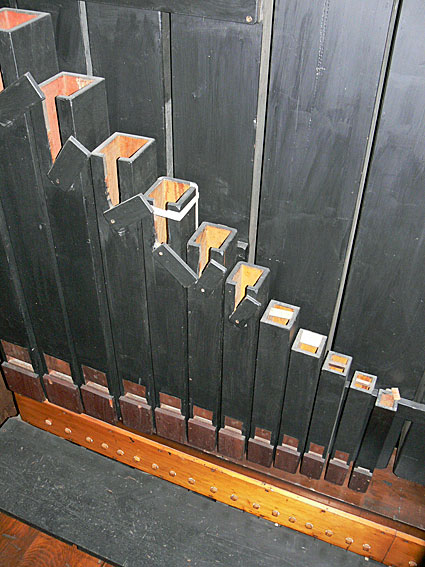
Tuning flaps of wooden Pedal pipes, fully opened up to raise the pitch
[Photograph by John Maidment (December 2009)]
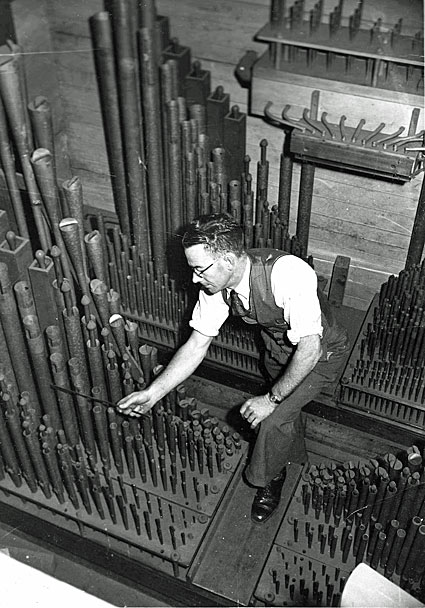
Mr Joe H. Whitehouse tuning pipes in the Swell Organ (undated)
Coned-out trebles of the Swell Mixture can be seen at the rear
[Photograph from the collection of Margery Horn]
There have been suggestions that some (or all) of the reeds were returned to England for re-voicing in 1927-29, and that the weights on the tongues are no longer 'screwed on' as they were originally. Each of the reed ranks, like the flues, was supplied with a new bottom note in 1927-29 when the pitch of the organ was lowered, but there is no evidence that they were re-voiced in any significant way. During the 2010-14 restoration, it was found that most of the weights on the reed tongues are still 'screwed on' in the original manner, although some of the screws had been discarded and the weights simply glued on.29 The most significant alteration to the speech of the reeds, therefore, came in 1938 when the pitch of the organ was raised.
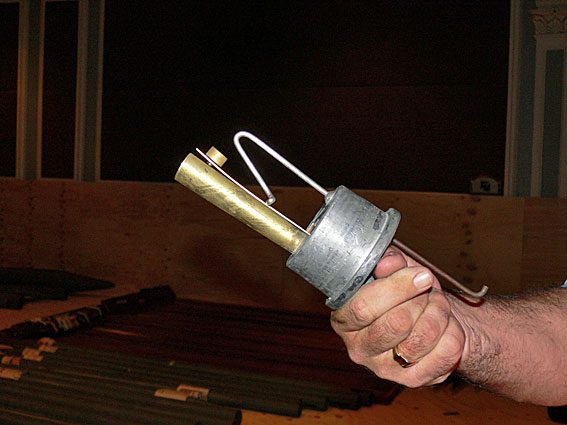
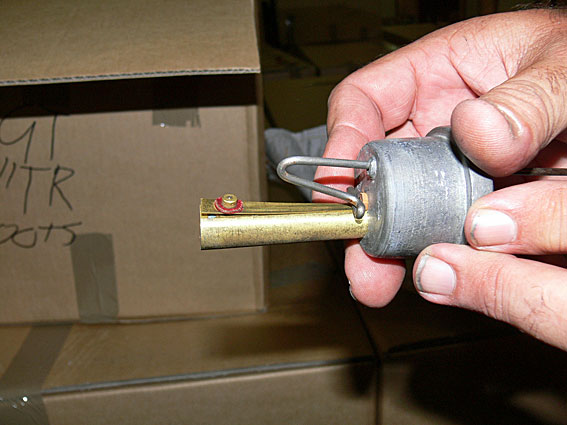
Screwed-on weights on the reeds
[Photographs by John Maidment (January 2010)]
Another notable alteration to the organ in the 1930s was the shifting of the console to its present position in 1933.30 It had been located originally at the edge of the stage.
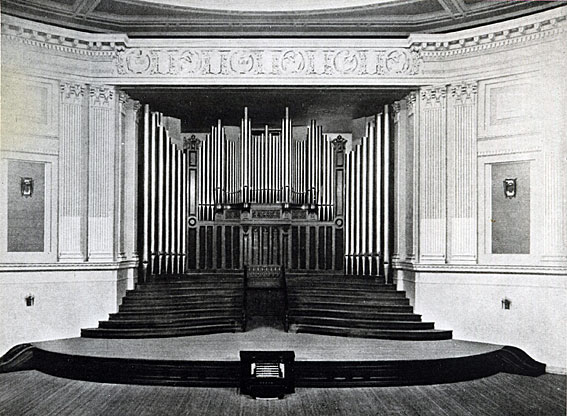
The console in its original position
[Photograph from the opening recital programme (Tuesday, 8 April 1930)]
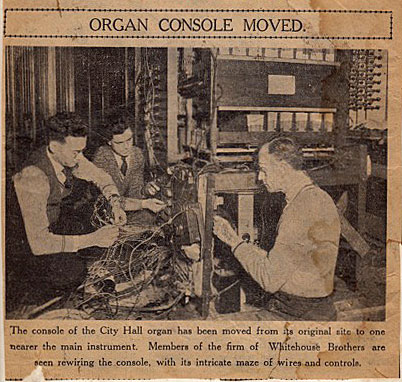
Newspaper clipping from The Brisbane Courier (22 August 1933), p. 14
Mr Joe H. Whitehouse can be seen on the left, and Mr Darrel McMullan immediately behind him.
The increasingly dilapidated condition of the organ was giving rise to concern in the early 1970s.31 A degree of controversy obviously surrounded the early negotations for its refurbishment, and at least one published scheme was abandoned.32 A contract for the renovation of the organ was eventually awarded to Messrs Brown and Arkley Pty Ltd of Sydney, and work commenced in February 1988, including the following:
• Relocation of the previously scattered Solo Organ on a new platform, with a new slider soundboard for the Tuba section allowing for the addition of Contra Tuba 16ft and Tuba Clarion 4ft.
• Relocation of the Choir Organ onto the main building frame, very close to its 1891-92 position.
• Supplying a new piston capture system, including memory capacity and a settable Tutti.
• Addition of Great Furniture IV; Choir Sesquialtera II (in place of the former Rohr Gedackt 16ft); and Pedal Mixture IV (in place of the Echo Bass 16ft).33
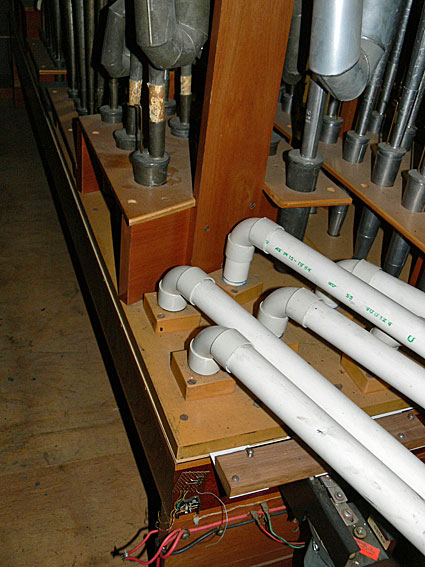
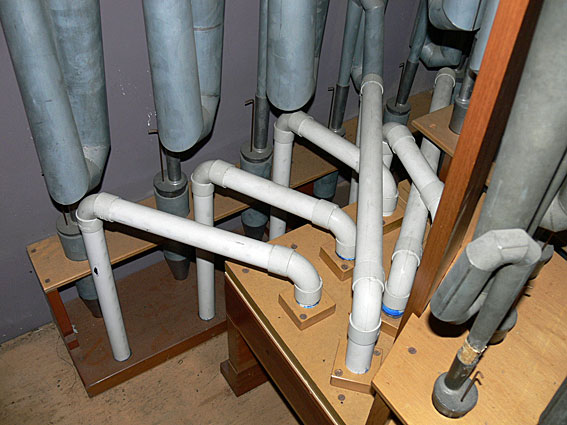
Examples of wind conveyancing following the 1988-91 renovation
[Photographs by John Maidment (December 2009)]
The renovated organ was officially re-opened at a concert on 3 December 1991 in the regular "Music at Midday" series, featuring the City Organist, Mr Robert Boughen, and other local musicians. Further work of renovation on the organ continued in the 1990s under the care of W.J. Simon Pierce of Brisbane. This included the refurbishment and repositioning of the Diapason Stentor chest and repositioning of the 32ft Pedal reed chest in 1997.34
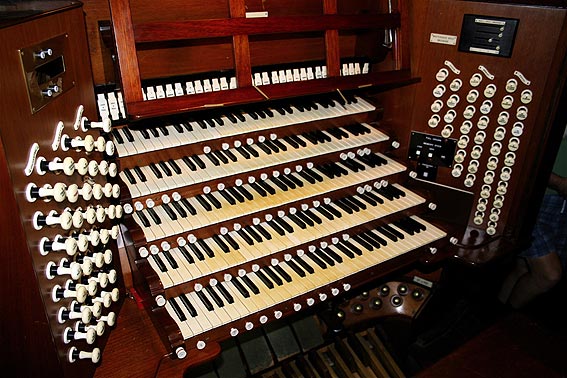
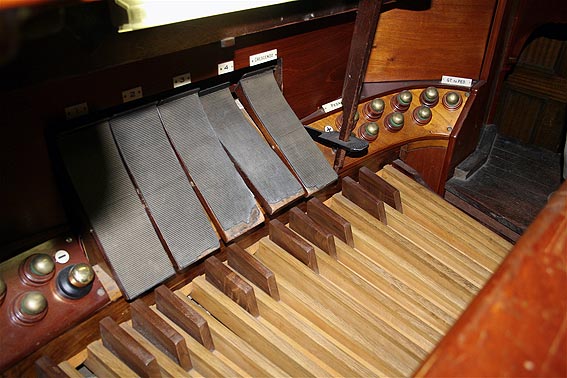
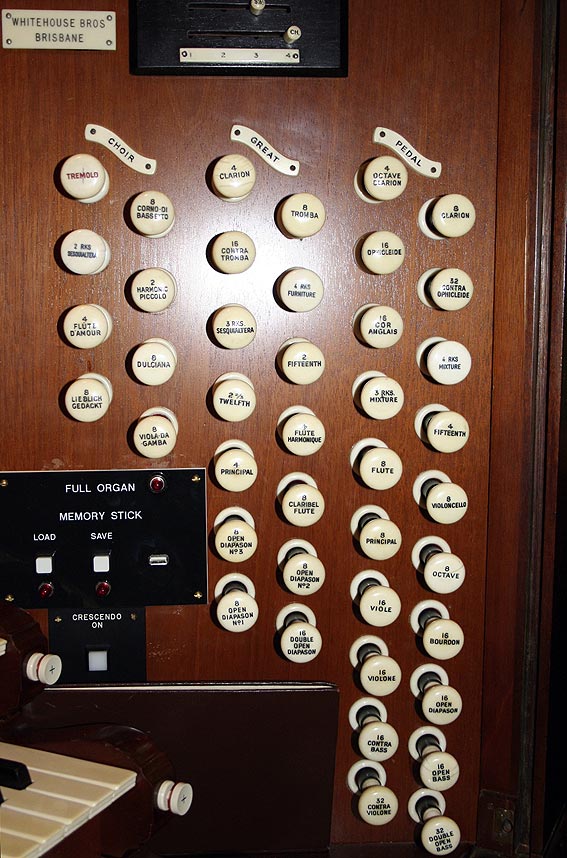
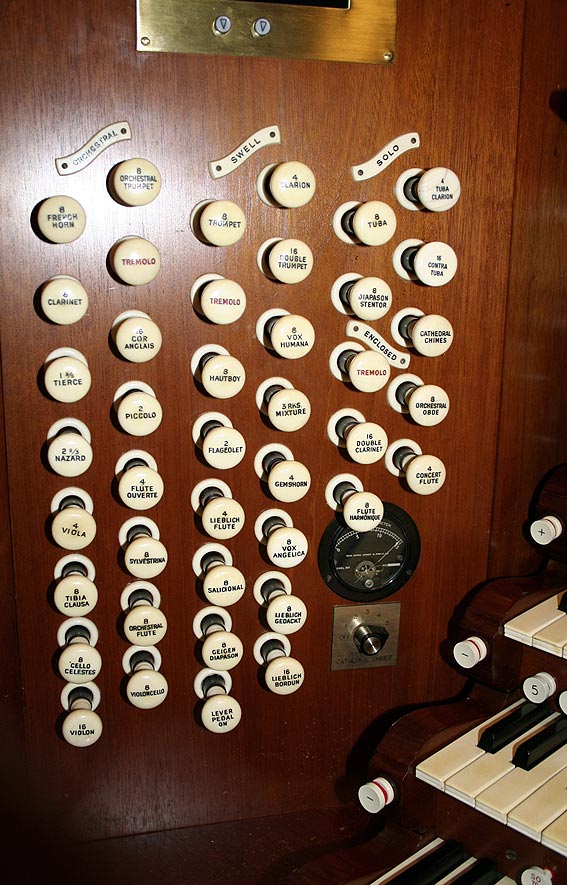
Console details, including additions and changes by Brown & Arkley, 1988-91
[Photographs by Trevor Bunning (October 2007)]
Following the discovery of major structural problems in the foundations of the City Hall, the decision was made in 2009 to close the building for around three years, and to remove the organ to storage at the start of 2010. An '80th Anniversary Celebration' concert was presented on Saturday 14 November 2009, with organists Christopher Wrench and Rupert Jeffcoat, together with various presentations commemorating the life and history of the instrument.35
A complete restoration of the organ was commissioned by the Brisbane City Council in August 2010, the contract being awarded to Pierce Pipe Organs Pty Ltd of Brisbane, with John Maidment OAM of Melbourne as consultant.
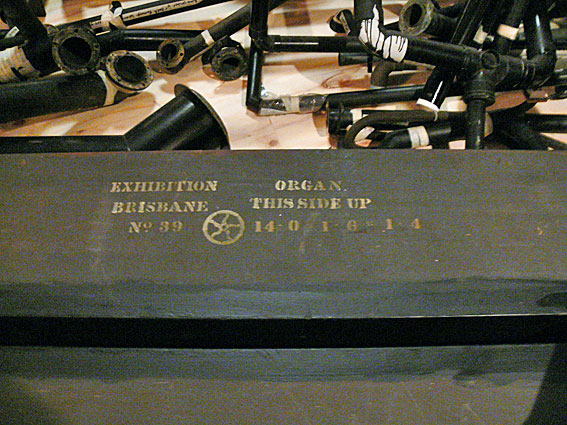
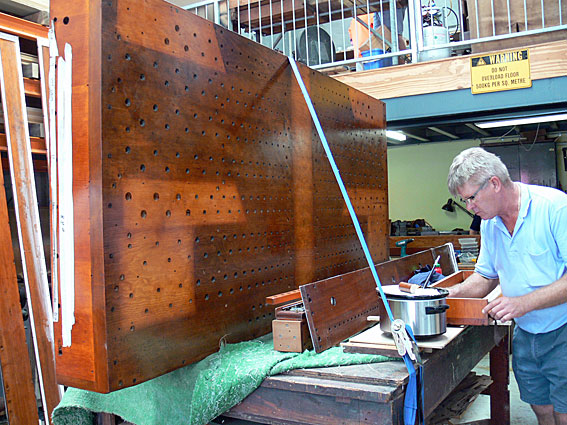
Parts of the organ under restoration in the factory of Pierce Pipe Organs Pty Ltd, Brisbane
[Photographs by John Maidment (March 2011)]
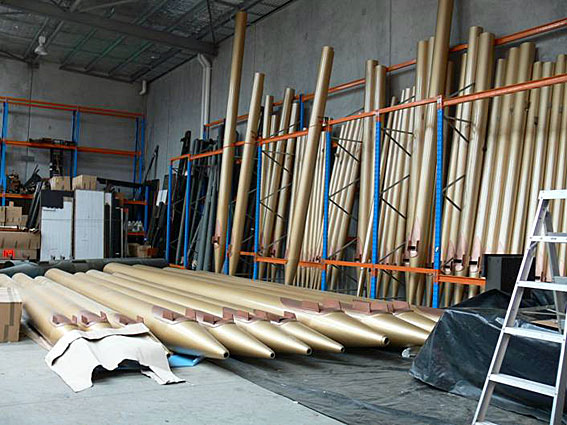
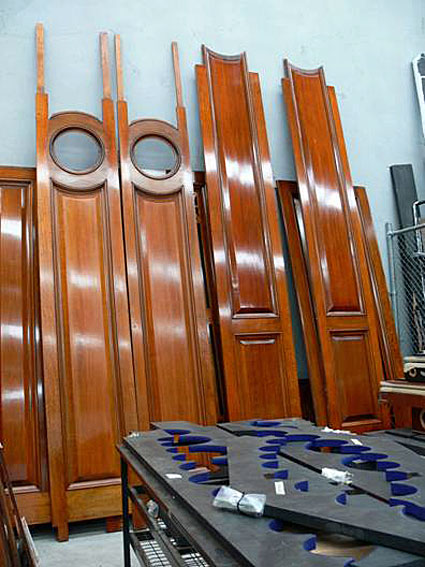
Repainted façade pipes and restored casework panels
[Photographs by John Maidment (September 2012)]
The philosophy underpinning the restoration of 2010-14 was to retain the specification of 1929, while retaining also the Great Fourniture IV and Solo Tubas at 16ft and 4ft added in 1991. The Choir Rohr Gedact 8ft and Pedal Echo Bass 16ft that had been removed in 1991 were reinstated. The Choir Sesquialtera II and Pedal Mixture IV added in 1991 have been removed. A completely new blowing plant was provided by the German firm of Laukhuff, located in a specially constructed room at the highest level within the organ, replacing two wood-encased Kinetic blowers from the early twentieth century and a third blower supplied by the Willis firm in 1929.36
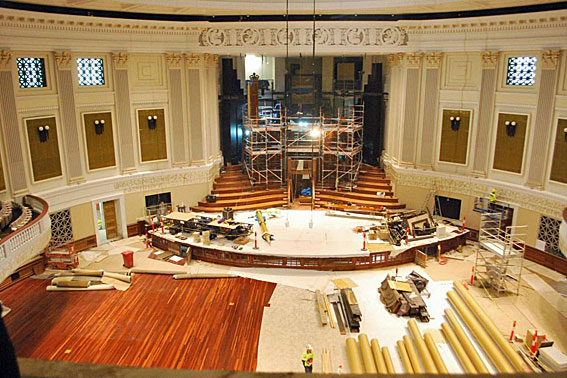
The organ being re-installed at the City Hall (2013)
[Photograph supplied by the Brisbane City Council
for ABC News (1 August 2014)]
Problems caused by earlier alterations to the pitch of the instrument were addressed by removing the bottom pipe added in 1927-29 to each of the 1892 reed ranks, and returning these to optimum speech.37 The overall work involved comprehensive restoration of the pipework, chests, action and winding, and the manufacture of a Willis replica slider chest for the Solo Tubas. The console was fully restored, including new thumb pistons matching the Willis III design, to replace non-matching ones added in 1991. The grey paint on the façade pipes, which were originally diapered, was removed, and they were repainted in a new gilt finish.38
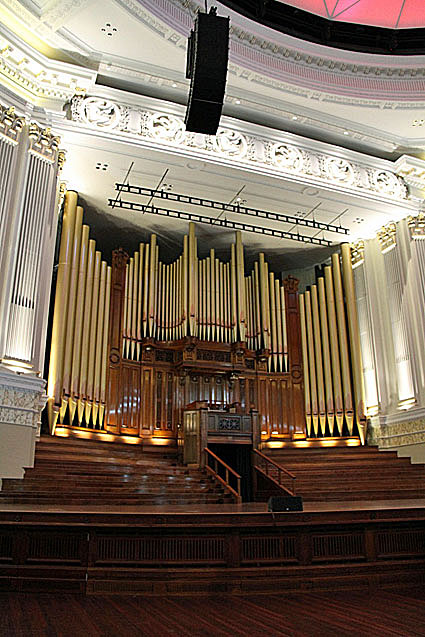
The restored City Hall organ, including repainted façade pipes
[Photograph by Simon Pierce (January 2014)]
The City Hall was re-opened on Saturday 6 April 2013. Many heritage features were restored, while modern features included the LED lighting system in the main auditorium's domed ceiling. The organ was re-opened at 11.30am on Sunday 10 August 2014 with a concert presented by organists, Thomas Heywood and Andrej Kouznetsov, followed by two Silent Movie presentations the same evening with organist, David Bailey.39
GREAT ORGAN |
|
|
|
[1929; heavy pressure] ['Furniture'1991; renamed 2014] [renamed as in 1892; 'Contra Tromba' in 1929] [renamed as in 1892; 'Tromba' in 1929] |
SWELL ORGAN |
[enclosed] |
|
|
['Geigen Principal' 1892; renamed in 1927] [renamed as in 1892; 'Trumpet' in 1929] |
CHOIR ORGAN |
[enclosed] |
|
|
[removed 1991; reinstated 2014] |
SOLO ORGAN |
|
|
|
[unenclosed, except as indicated] [enclosed] [enclosed] [enclosed] [enclosed] [heavy pressure] [1-12 new 1991; remainder 'Tuba 8' 1892] [1991; renamed 2014] [1991] [20 notes] |
ORCHESTRAL ORGAN |
[enclosed] |
|
|
[all added in 1929] [heavy pressure] [heavy pressure] |
| PEDAL ORGAN Double Open Bass Contra Violone Open Bass Contra Bass Open Diapason Violone Bourdon Viole Echo Bass Octave Principal Violoncello Flute Fifteenth Mixture Cor Anglais Contra Ophicleide Ophicleide Clarion Octave Clarion |
32 32 16 16 16 16 16 16 16 8 8 8 8 4 3 ranks 16 32 16 8 4 |
A B A C D B J E F A D C J D H I I |
wood metal wood metal metal metal std. wood metal std. wood wood metal metal std. wood metal metal metal metal metal metal metal |
[1-12, 1929] ['Open Diapason' 1892] [1929; heavy pressure] [1929] [1929] [removed 1991; reinstated 2014] [1929] [1929] ['Flute Bass' 1892] [1929] [1929] [1929] [1-12, 1929; heavy pressure] [heavy pressure] ['Posaune' 1892; heavy pressure] [1929; heavy pressure] |
COUPLERS
Swell to Great Octave
Swell to Great Sub Octave
Swell to Great
Choir to Great
Orchestral to Great
Solo to Great
Swell Octave
Swell Sub Octave
Swell Unison Off
Orchestral to Swell
Choir Octave
Choir Sub Octave
Choir Unison Off
Swell to Choir
Solo to Choir
Orchestral to Choir
Solo Octave
Solo Sub Octave
Solo Unison Off
Orchestral Octave
Orchestral Sub Octave
Orchestral Unison Off
Solo to Orchestral
Solo to Pedal
Solo to Pedal 4-ft
Orchestral to Pedal
Orchestral to Pedal 4-ft
Swell to Pedal
Swell to Pedal 4-ft
Great to Pedal
Choir to Pedal
Choir to Pedal 4-ft
Swell tremolo to light wind
Choir tremolo
Solo tremolo to light wind
Orchestral tremolo to light wind
Great and Pedal Combinations coupled
7 pistons to the Great Organ (adjustable)
7 pistons to the Swell Organ (adjustable; duplicated by toe pistons)
7 pistons to the Orchestral Organ (adjustable)
5 pistons to the Choir Organ (adjustable)
5 pistons to the Solo Organ (adjustable)
7 pistons to the Pedal Organ (adjustable)
10 General Pistons [4 General Pistons in 1929, duplicated in treble and bass key frames]
1 reversible piston to Great to Pedal (duplicated by toe piston)
1 reversible piston to Swell to Great (in Great key slip)
1 reversible piston to Choir to Great (in Great key slip)
1 reversible piston to Orchestral to Great (in Great key slip)
1 reversible piston to Solo to Great (in Great key slip)
1 reversible piston to Gt. & Ped. Combinations coupled (in Great key slip)
1 reversible piston to Swell to Pedal (in Swell key slip)
1 reversible piston to Orchestral to Swell (in Swell key slip)
1 reversible piston to Orchestral to Pedal (in Orchesral key slip)
1 reversible piston to Solo to Orchestral (in Orchesral key slip)
1 reversible piston to Solo to Pedal (in Solo key slip)
1 reversible piston to Choir to Pedal (in Choir key slip)
1 reversible piston to Swell to Choir (in Choir key slip)
1 reversible piston to Orchestral to Choir (in Choir key slip)
1 reversible piston to Solo to Choir (in Choir key slip)
1 'General Cancel' piston (in Choir key slip)
1 locking piston for adjusting combinations (in Choir key slip)
Sequencer [added 1991]
Compass: 61/30
Balanced Crescendo Pedal with indicator
Full Organ by reversible toe piston with indicator
Balanced Swell Pedals to Swell, Solo, Orchestral and Choir
Electro-pneumatic action throughout
Lever pedal duplicating Balanced Pedal
Switchplate for setting order of swell pedals.40
______________________________________________________________________________
1 Queensland Heritage Council, Queensland Heritage Register, location 600065; The Heritage of Australia: The Illustrated Register of the National Estate (South Melbourne: Macmillan, 1981), 4/14.
2 George Fincham Letter Book 13, pp. 412-17 (10 March 1887).
3 A more detailed account of the negotiations for the acquisition of this organ can be found in: Geoffrey Cox, 'The Willis Organ at the Exhibition Concert Hall in Brisbane: The Finest in the City,' OHTA News, vol. 34, no. 4 (October 2010), pp. 17-28.
4 Henry Willis [III], 'Brisbane City Hall: A Notable Enlargement of a Notable Organ,' The Rotunda, vol. 2, no. 1 (September 1927), pp. 1-2.
5 The Brisbane Courier (10 Sept 1892), p. 4.
6 The Brisbane Courier (6 Oct 1892), p. 6.
7 The Brisbane Courier (19 December 1892), pp. 5-6. Details in square brackets derive from: Henry Willis [III], op. cit. Willis III appears to have altered the spelling of several original stop names. He also omitted the Swell to Choir coupler, and gave the Swell to Great Sub and Super couplers respectively as 'Swell Sub Octave (on itself)' and 'Swell Super Octave (on itself)'. The preparation for a 16ft reed stop on the Great is also recorded in the specification recorded by Percy Brier at Exhibition Building (supplied by R.K. Boughen), where it is described as 'Trombone 16'. The latter source also confirms the details of couplers as reported in The Brisbane Courier (19 December 1892).
8 A slightly cropped version of this photograph had appeared in The Daily Mail (10 March 1906), p. 9.
9 Frederic Rogers, 'City Hall Organ,' manuscript in John Oxley Library, State Library of Queensland; rpt. in OHTA News, vol. 14, no. 2 (April 1990), p. 13-14.
10 The Brisbane Courier (20 December 1892), p. 2; The Brisbane Courier (21 December 1892), p. 5; Evening Observer (21 December 1982), p. 4.
11 The Brisbane Courier (27 August 1894), p. 6.
12 The Brisbane Courier (28 August 1894). p. 2; The Brisbane Courier (29 August 1894), p. 2; The Brisbane Courier (30 August 1894), p. 4; The Brisbane Courier (31 August 1894), pp. 5 & 6.
13 The Brisbane Courier (1 November 1894), p. 6.
14 The Brisbane Courier (23 February 1897), p. 6; The Brisbane Courier (31 March 1898), p. 4; The Brisbane Courier (1 April 1898), p. 4; The Brisbane Courier (7 April 1898), p. 5.
15 F. J. Brewer and R. Dunn, Sixty-six Years of Municipal Government (Brisbane: Standard Press, 1925), pp. 125-27.
16 The Brisbane Courier (16 April 1925), p. 8; The Brisbane Courier (5 March 1927), p. 16; Unidentified newspaper dated 16 July 1928, supplied to G. Cox by Mr Howell Whitehouse, 2010.
17 The Brisbane Courier (11 April 1928), p. 18.
18 The Brisbane Courier (9 April 1930), p. 25
19 The Telegraph (8 July 1929), p. 16.
20 Whitehouse Bros Ledger (1922-1940), pp. 259-60.
21 Interview with Mr Darrel McMullen at OHTA conference, 30 September 1989.
22 The Brisbane Courier (19 June 1929), p. 12.
23 Interview with Mr Darrel McMullen, op. cit.
24 Willis, op. cit., pp. 3-7. The specification agreed substantially with that printed in the Opening Programme (8 April 1930), although some of the original 1892 stop nomenclature had been changed. See current specification, below.
25 The Courier-Mail (9 November 1937), p. 13.
26 Whitehouse Bros Ledger (1922-1940), p. 385.
27 The Telegraph (12 August 1938), p. 7.
28 see also: Geoffrey Cox, 'More on Organ Pitch: Brisbane City Hall,' OHTA News, vol. 34, no. 2 (April 2010), pp. 22-25.
29 [John Maidment,] 'Restorations: Brisbane City Hall,' OHTA News, vol. 38, no. 2 (April 2014), pp. 9-10.
30 Whitehouse Bros Ledger (1922-1940), p. 533.
31 The Sunday Mail (24 March 1974), p. 24 and (9 June 1974), p. 3; The Courier Mail (2 January 1976), p. 2.
32 The Courier Mail (11 October 1984), p. 2; OHTA News, vol. 9, No 2 (April 1985), pp. 16-17; The Courier Mail (30 April 1987), p. 17.
33 Ian Brown, 'The Brisbane City Hall Organ,' Organ Society of Queensland Newsletter, vol. 16, no. 6 (June 1989), pp. 5-11 & Organ Society of Queensland Newsletter, vol. 19, no. 1 (August 1991), pp. 10-23; see also: Organ Society of Queensland Newsletter, vol. 17, no. 4 (February 1990), p. 17 & subsequent correspondence in The Organ Voice, vol. 24, no. 1 (March 1998), pp. 28-29.
34 W.J. Simon Pierce Newsletter (Winter 1997).
35 Organ Australia, vol. 6, no. 1 (March 2010), pp. 40-43.
36 [Maidment,] op. cit., p. 13; further details in W.J. Simon Pierce, 'Brisbane City Hall's Willis Pipe Organ,' The Sydney Organ Journal, vol. 46, no. 4 (Spring 2015), pp. 23-26.
37 [Maidment,] op. cit., pp. 7-8; Personal communications to G. Cox from John Maidment and Simon Pierce, 2011-12.
38 [Maidment,] op. cit., pp. 5-15; OHTA News, vol. 34, no. 2 (April 2010), p. 4; OHTA News, vol. 34, no. 3 (July 2010), p. 9; OHTA News (April 2011), p. 4; OHTA News, vol. 36, no. 1 (January 2012), p. 8; OHTA News, vol. 36, no. 2 (April 2012), p. 4.
39 An account of the opening concerts appears in: David Vann, 'Concerts bring Brisbane's City Organ back to life,' Organ Australia (Spring 2014), pp. 24-27.
40 The specification printed by Willis in The Rotunda, op. cit., pp. 3-7 agrees substantially with that printed in the Opening Programme (8 April 1930). Changes made in 2014 have been taken from [Maidment], op. cit., pp. 14-15.